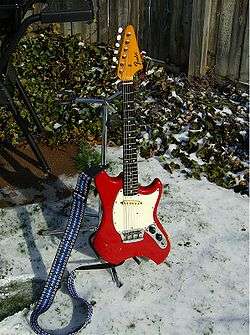Fender Swinger
The Fender Swinger (also known as the Fender Musiclander and Fender Arrow – as the "Swinger" emblem is usually missing from the headstock) was a short-lived electric guitar model released by Fender in 1969, with few made. The Swinger was an attempt by CBS (which had bought the company in 1965) to extract cash from inventory by combining unused bodies from the failed Fender Bass V with parts from the Fender Musicmaster. Another use of surplus stock was the Fender Custom (a.k.a. Fender Maverick). The Swinger was marketed as another cheaper, short-scale 'student' guitar, but never seriously promoted, with resulting low popularity.[1]
| Fender Swinger | |
|---|---|
 | |
| Manufacturer | Fender |
| Period | 1969 |
| Construction | |
| Body type | Solid |
| Neck joint | Bolt-on |
| Scale | 22.5 in (572 mm) |
| Woods | |
| Neck | Maple |
| Fretboard | Rosewood |
| Hardware | |
| Bridge | Fixed (non-tremolo), 3-saddle adjustable |
| Pickup(s) | 1 single-coil pickup, offset variant (reverse polarity) |
| Colors available | |
| include Dakota Red, Black, Candy Apple Red, Olympic White, Sonic Blue, Lake Placid Blue | |
Development and design
The Swinger and its cousin, the Custom, were both developed under the supervision of Virgilio 'Babe' Simoni, without the help or even involvement of Fender's R&D Department. Simoni had begun work at Fender in 1953, at age 16. He had risen to Product Manager by the mid Sixties, and was both skilled and well-liked within the company. The Swinger used excess parts from the Fender Bass V and Fender Musicmaster, with the Bass V pickup routing hidden under the pickguard. Between 300 and 600 Swingers were produced, and the model never appeared in any Fender literature.[2]
Dating
As the Swinger was built using parts that were surplus, the individual components may be older than the guitar. For example, the neck may be datestamped 1966. As far as is known, all Swingers were assembled in 1969. There are estimates that only 250 to 300 Swingers were ever produced.[3]
Users
Tina Weymouth of Talking Heads used a Swinger in live performances, as seen in the concert movie Stop Making Sense. Ben Kweller used a Swinger to record most of his self-titled album, and has used it in concert. Lydia Night of The Regrettes uses a Swinger live and in the band's Seashore music video. John Smith of Mux used a swinger on the hit single We Need Love and the rest of that album.[4]
References
- Bacon, Tony (2000). 50 Years of Fender: Half a Century of the Greatest Electric Guitars. Backbeat Books. p. 128 pages. ISBN 0-87930-621-1.
- Kelly, Martin; Foster, Terry; Kelly, Paul (2010). The Golden Age of Fender, 1946–1970. Cassell Illustrated. p. 287 pages. ISBN 978-1-84403-701-8.
- Fjestad, Zachary (2009). Blue Book of Electric Guitars. Blue Book. p. 325. ISBN 1-886768-93-5.
- Mux Official Biography